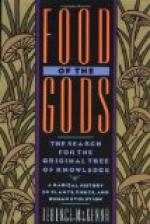The preparation of the land is the first and greatest expense; trees have to be felled, and bush cut down and spread over the land, so that the sun can quickly render it combustible. When all is clear, the cacao is put in among a “catch crop” of vegetables (the cassava, tania, pigeon-pea, and others), and frequently bananas, though, as taking more nutriment from the soil, they are sometimes objected to. But the seedling cacao needs a shade, and as it is some years before it comes into bearing, it is usual to plant the “catch crop” for the sake of a small return on the land, as well as to meet this need.
In Trinidad, at the same time that the cacao[10] is planted at about twelve feet centres, large forest trees are also planted at from fifty to sixty feet centres, to provide permanent shade. The tree most used for this purpose is the Bois Immortelle (Erythrina umbrosa); but others are also employed, and experiments are now being made on some estates to grow rubber as a shade tree. In recent clearings in Samoa, trees are left standing at intervals to serve this end.
[Illustration—Black and White Plate: Samoa: Cacao in its fourth Year.]
In Grenada, British West Indies, and some other districts, shade is entirely dispensed with, and the trees are planted at about eight feet centres, thus forming a denser foliage. By this means at least 500 trees will be raised on an acre, against less than 300 in Trinidad, the result showing almost invariably a larger output from the Grenada estates. This practice is better suited to steep hillside plantations than to those in open valleys or on the plains.
The cacao leaves, at first a tender yellowish-brown, ultimately turn to a bright green, and attain a considerable size, often fourteen to eighteen inches in length, sometimes even larger. The tree is subject to scale insects, which attack the leaf, also to grubs, which quickly rot the limbs and trunks, this last being at one time a very serious pest in Ceylon. If left to Nature the trees are quickly covered lichen, moss, “vines,” ferns, and innumerable parasitic growths, and the cost of keeping an estate free from all the natural enemies which would suck the strength of the tree and lessen the crop is very great.
[Illustration—Black and White Plate: Young Cultivation, with catch Crop of Bananas, Cassava, and Tania: Trinidad.]
The cacao will bloom in its third year, but does not bear fruit till its fourth or fifth. The flower is small, out of all proportion to the size of the mature fruit. Little clusters of these tiny pink and yellow blossoms show in many places along the old wood of the tree, often from the upright trunk itself, and within a few inches of the ground; they are extremely delicate, and a planter will be satisfied if every third or fourth produces fruit. In dry weather or cold, or wind, the little pods only too quickly shrivel into black shells; but if the season




